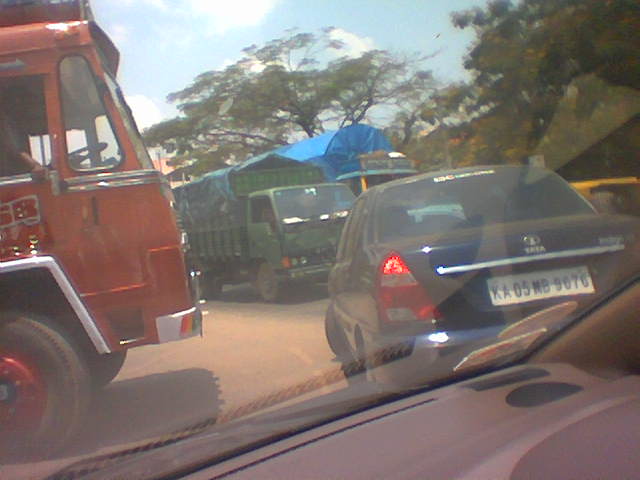
This is an attempt to recast the state of Bangalore’s traffic, oft maligned for its apparent state of anarchy, in the light of a more organized overarching structure guided by empirically observable principles. While the functioning of its various components may seem arbitrary and chaotic, I propose that in fact, Bangalore’s traffic represents the purest capitalistic system in the known world.
Firstly, as in any capitalistic system, the basis of Bangalore’s traffic and its state of obdurate existence in the face of an almost self-destructive façade has to do with the dynamic interaction of a group of properly functioning individual vehicular units. The comparison goes further, in that it is imperative that each of these units function with the purest intention of self-gain. In such a system, not only are the needs of each unit met, but the welfare of each unit also is directly dependant on the selfishness of its comrade-on-wheels. To exemplify, only if my comrade seeks, in dire recklessness, to cut off oncoming traffic am I able to proceed towards my destination through the path he has cleared by his brash egomania. He has no particular affection for me or mine, but his actions reflect unbidden altruism and symbiosis.
Secondly, as in most market economies, any attempt at governmental regulation is often detrimental to the welfare of all parties concerned. Despite their heroism, no Bangalore Traffic Police official has ever done anything more by directing traffic flow than succeed in creating greater chaos than when he or she arrived.
Finally, this traffic system follows a system of social justice that most capitalist economies are unable to create in their hunger for greater profit. This trait does not run counter to the capitalist ideal, but in fact embodies its very nature. In Bangalore’s system, there is a true sense of vehicular equality as each unit is afforded no more power than its comrade. Unlike the imperfect manifestations of the capitalist system we see elsewhere in which units join together in leviathan-like ‘conglomerates’, Bangalore’s units follow Chandy’s Law of Positional Preeminence, which states that
All vehicular units, regardless of spatial influence, must acquiesce and duly react to the choices of the vehicular unit to its anterior.
A less eloquent but equally insightful corollary to the law formulated by AbhiBass Koffee runs
The f***er behind him must sit and be happy that he’s in front of someone else.
Further insights, laws and criticisms are welcome.


4 comments:
haha very clever indeed.also,'so many pedestrians..such little time!'
Maybe Capitalism is a macroscopic representative of quantum mechanics. The laws of repulsion are visible through the smoggy haze from any suitably high rooftop if the observer is so inclined. I have other ideas about emergent behaviour of swarms, that I dare not indulge in for fear of losing chick points.
Hehehehehe!
Post a Comment